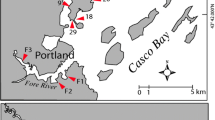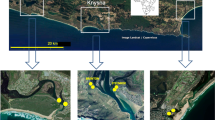Abstract
Narrow fringing salt marshes dominated by Spartina alterniflora occur naturally along estuarine shorelines and provide many of the same ecological functions as more extensive marshes. These fringing salt marshes are sometimes incorporated into shoreline stabilization efforts. We obtained data on elevation, salinity, sediment characteristics, vegetation and fish utilization at three study sites containing both natural fringing marshes and nearby restored marshes located landward of a stone sill constructed for shoreline stabilization. During the study, sediment accretion rates in the restored marshes were approximately 1.5- to 2-fold greater than those recorded in the natural marshes. Natural fringing marsh sediments were predominantly sandy with a mean organic matter content ranging between 1.5 and 6.0%. Average S. alterniflora stem density in natural marshes ranged between 130 and 222 stems m−2, while mean maximum stem height exceeded 64 cm. After 3 years, one of the three restored marshes (NCMM) achieved S. alterniflora stem densities equivalent to that of the natural fringing marshes, while percentage cover and maximum stem heights were significantly greater in the natural than in the restored marshes at all sites. There was no significant difference in the mean number of fish, crabs or shrimp captured with fyke nets between the natural and restored marshes, and only the abundance of Palaemonetes vulgaris (grass shrimp) was significantly greater in the natural marshes than in the restored ones. Mean numbers of fish caught per 5 m of marsh front were similar to those reported in the literature from marshes adjacent to tidal creeks and channels, and ranged between 509 and 634 fish net−1. Most of the field data and some of the sample analyses were obtained by volunteers as they contributed 223 h of the total 300 h spent collecting data from three sites in one season. The use of fyke nets required twice as many man-hours as any other single task. Vegetation and sediment parameters were sensitive indicators of marsh restoration success, and volunteers were capable of contributing a significant portion of the labor needed to collect these parameters.




Similar content being viewed by others
References
Able KW, Nemerson DM, Light PR et al (2000) Initial response of fishes to marsh restoration at a former salt hay farm bordering Delaware Bay. In: Weinstein MP, Kreeger DA (eds) Concepts and controversies in tidal marsh ecology. Kluwer, Dordrecht
Airoldi L, Abbiati M, Beck MW et al. (2005) An ecological perspective on the deployment and design of low-crested and other hard coastal defence structures. Coastal Eng 52:1073–1087
Allen DM, Edwards D, Feller RF et al. (1997) Detection and analysis of unusual events in long-term zooplankton and nekton data sets from North Inlet Estuary, SC, USA. Oceanol Acta 20:165–175
Barnard T (2004) Preserving the bay’s living shorelines: a growing grass-roots effort. Va Wetlands Rep 19:1–2
Bozek CM, Burdick DM (2005) Impacts of seawalls on salt marsh plant communities in the Great Bay Estuary, New Hampshire, USA. Wetlands Ecol Manage 13:553–568
Braun-Blanquet J, Fuller GD, Conard HS (1932) Plant sociology: the study of plant communities. McGraw-Hill, New York
Broome SW, Seneca ED, Woodhouse WW Jr (1986) Long-term growth and development of transplants of the salt-marsh grass Spartina alterniflora. Estuaries 9:63–74
Brown SC, Veneman PLM (2001) Effectiveness of compensatory wetland mitigation in Massachusetts, USA. Wetlands 21:508–518
Byrd KB, Kelly M (2006) Salt marsh vegetation response to edaphic and topographic changes from upland sedimentation in a Pacific estuary. Wetlands 26:813–829
Childers DL, Sklar FH, Drakes B et al (1993) Seasonal measurements of sediment elevation in three mid-Atlantic estuaries. J Coast Res 9:986–1003
Clarke KR, Gorley RN (2001) Primer-E version 5. Plymouth Marine Laboratory, Plymouth
Craft CB (2000) Co-development of wetland soils and benthic invertebrate communities following salt marsh creation. Wetlands Ecol Manage 8:197–207
Craft CB, Sacco JN (2003) Long-term succession of benthic infauna communities on constructed Spartina alterniflora marshes. Mar Ecol Prog Ser 257:45–58
Craft CB, Seneca ED, Broome SW (1993) Vertical accretion in regularly and irregularly flooded microtidal estuarine marshes. Estuar Coast Shelf Sci 37:371–386
Craft C, Reader J, Sacco JN et al. (1999) Twenty-five years of ecosystem development of constructed Spartina alterniflora (Loisel) marshes. Ecol Appl 9:1405–1419
Davis JL, Levin LA, Walther SM (2002) Artificial armored shorelines: sites for open-coast species in a southern. Calif Bay Mar Biol 140:1249–1262
Elzinga CL, Salzer DW, Willoughby JW (1998) Measuring and monitoring plant populations. Technical Reference 1730-1. United States Department of the Interior, Bureau of Land Management, National Business Center, Denver
Gleason ML, Elmer DA, Pien NC, Fisher JW (1979) Effects of stem density upon sediment retention by salt marsh cord grass, Spartina alterniflora Loisel. Estuaries 2:271–274
Hettler WF Jr (1989) Nekton use of regularly-flooded saltmarsh cordgrass habitat in North Carolina, USA. Mar Ecol Prog Ser 56:111–118
Hudson SJ (2001) Challenges for environmental education: issues and ideas for the 21st century. Bioscience 51:283–288
Kastler JA, Wiberg PL (1996) Sedimentation and boundary changes of Virginia salt marshes. Estuar Coast Shelf Sci 42:683–700
Konisky RA, Burdick DM, Dionne M et al. (2006) A regional assessment of salt marsh restoration and monitoring in the Gulf of Maine. Restor Ecol 14:516–525
Knutson PL (1988) Role of coastal marshes in energy dissipation and shore protection. In: Hook DD et al (eds) The ecology and management of wetlands. Ecology of wetlands, vol 1. Crook Helm, London, pp 161–175
Leonard LA, Wren PA, Beavers RL (2002) Flow dynamics and sedimentation in Spartina alterniflora and Phragmites australis marshes of the Chesapeake Bay. Wetlands 22:415–424
MacIntyre HL, Geider RJ, Miller DC (1996) Microphytobenthos: the ecological role of the ‘Secret Garden’ of unvegetated, shallow-water marine habitats. I. Distribution, abundance and primary production. Estuaries 19:186–201
Markovchick-Nicholls L, Dean T, Bloch P et al. (2004) Sound stewardship-using citizen-based restoration monitoring as a tool for adaptive management. Proc 2003 Ga Basin/Puget Sound Res Conf.
Martin D, Bertasi F, Colangelo MA et al (2005) Ecological impact of coastal defense structures on sediment and mobile fauna: evaluating and forecasting consequences of unavoidable modifications of native habitats. Coast Eng 52:1027–1051
Meyer DL, Townsend EC, Thayer GW (1997) Stabilization and erosion control value of oyster clutch for intertidal marsh. Restor Ecol 5:3–99
Minello TJ, Zimmerman RJ (1992) Utilization of natural and transplanted Texas salt marshes by fish and decapod crustaceans. Mar Ecol Prog Ser 90:273–285
Minello TJ, Zimmerman RJ, Medina R (1994) The importance of edge for natant macrofauna in a created salt marsh. Wetlands 14:184–198
Minello TJ, Webb JW (1997) Use of natural and created Spartina alterniflora salt marshes by fishery species and other aquatic fauna in Galveston Bay, Texas, USA. Mar Ecol Prog Ser 151:165–179
Mock CR (1966) Natural and altered estuarine habitats of penaeid shrimp. Proc Gulf Caribb Fish Inst 19:86–98
Morgan PA, Short FT (2002) Using functional trajectories to track constructed salt marsh development in the Great Bay Estuary, Maine/New Hampshire, U.S.A. Restor Ecol 10:461–473
Morris JT, Haskin B (1990) A 5-yr record of aerial primary production and stand characteristics of Spartina alterniflora. Ecology 71:2209–2217
Morris JT, Sundareshwar PV, Nietch CT et al. (2002) Responses of coastal wetlands to rising sea level. Ecology 83:2869–2877
National Research Council (2007) Mitigating shore erosion along sheltered coasts. The National Academies Press, Washington D.C.
Neckles HA, Dionne M, Burdick DM et al (2002) A monitoring protocol to assess tidal restoration of salt marshes on local and regional scales. Restor Ecol 10:556–563
Oscarson DB, Calhoun AJ (2007) Developing vernal pool conservation plans at the local level using citizen-scientists. Wetlands 27:80–95
Osgood DT, Zieman JC (1993) Spatial and temporal patterns of substrate physiochemical parameters in different-aged barrier island marshes. Estuar Coast Shelf Sci 37:421–436
Palmer MA, Bernhardt ES, Allan JD et al (2005) Standards for ecologically successful river restoration. J Appl Ecol 42:208–217
Peterson GW, Turner RE (1994) The value of salt marsh edge vs. interior as a habitat for fish and decapod crustaceans in a Louisiana tidal marsh. Estuaries 17:235–262
Piehler MF, Currin CA, Casanova R et al (1998) Development and N2-fixing activity of the benthic microalgal community in transplanted Spartina alterniflora marshes in North Carolina. Restor Ecol 6:290–296
Plumb RH (1981) Procedures for handling and chemical analyses of sediment and water samples. Environmental Laboratory, U.S. Army Engineer Waterways Experiment Station, Vicksburg, Miss.
Race MS, Fonseca MS (1996) Fixing compensatory mitigation: what will it take? Ecol Appl 6:94–101
Rogers SM, Broome SW, Seneca ED (1992) Shoreline erosion control using marsh vegetation and low-cost structures. N C Sea Grant Publ UNC-SG-92-12, Raleigh
Sacco JN, Seneca ED, Wentworth TR (1994) Infaunal community development of artificially established salt marshes in North Carolina. Estuaries 17:489–500
SAS Institute (1999) SAS version 8.02. Cary, N.C.
Seitz RD, Lipcius RN, Olmstead NH et al. (2006) Influence of shallow-water habitats and shoreline development upon abundance, biomass, and diversity of benthic prey and predators in Chesapeake Bay. Mar Ecol Prog Ser 3426:11–27
Sharpe A, Conrad CS (2006) Community based ecological monitoring in Nova Scotia: challenges opportunities. Environ Monit Assess 113:395–409
Simenstad CA, Thom RM (1996) Functional equivalency trajectories of the restored Gog-Le-Hi-Te estuarine wetland. Ecol Appl 6:38–56
Stumpf RP (1983) The process of sedimentation on the surface of a salt marsh. Estuar Coast Shelf Sci 17:495–508
Thayer GW, McTigue TA, Salz RJ et al. (eds) (2005) Science-based restoration monitoring of coastal habitats, vol 2: Tools for monitoring coastal habitats. NOAA Coastal Ocean Program Decision Analysis Series No.23. NOAA National Centers for Coastal Ocean Science, Silver Spring, Md.
Thom RM (1997) System-development matrix for adaptive management of coastal ecosystem restoration projects. Ecol Eng 8:219–232
Weinstein MP, Kreeger DA (eds) (2000) Concepts and controversies in tidal marsh ecology. Kluwer, Dordrecht
Weinstein MP, Teal JM, Balletto JH et al (2001) Restoration principles emerging from one of the world’s largest tidal marsh restoration projects. Wetlands Ecol Manage 9:387–407
Zedler JB, Calloway JC (1999) Tracking wetland restoration: do mitigation sites follow desired trajectories?. Restor Ecol 7:69–73
Zedler JB, Lindig-Cisneros R (2000) Functional equivalency of restored and natural salt marshes. In: Weinstein MP, Kreeger DA (eds) Concepts and controversies in tidal marsh ecology. Kluwer, Dordrecht, pp 565–582
Zedler JB (ed) (2001) Handbook for restoring tidal wetlands. CRC Press, Boca Raton
Acknowledgements
The NOAA Restoration Center and the NOS Center for Coastal Fisheries and Habitat Research provided funding for this project. J. Brewer provided valuable assistance in the field and laboratory; C. Addison, S. Slade and M. Johnson also assisted with fieldwork. D. Meyer helped with the overall sampling design and M. LaCroix aided in fish identification. M. Severin organized the 2001 sampling effort and developed several of the protocols. V. Nero provided assistance with the diversity indices and community similarities. We thank T. Skrabal and the North Carolina Coastal Federation for their cooperation and assistance. Dr. K. Fisher and E. Noble from Elizabeth City State University and their students provided valuable field assistance and performed sediment analyses. Many additional volunteers contributed time to this project and in particular, we thank F. Gaines, M. Rawls and the Carteret Community College Science Club, and P. Cader and the National Charity League, Morehead City Chapter.
Author information
Authors and Affiliations
Corresponding author
Additional information
The U.S. Government's right to retain a non-exclusive, royalty-free license in and to any copyright is acknowledged.
Rights and permissions
About this article
Cite this article
Currin, C.A., Delano, P.C. & Valdes-Weaver, L.M. Utilization of a citizen monitoring protocol to assess the structure and function of natural and stabilized fringing salt marshes in North Carolina. Wetlands Ecol Manage 16, 97–118 (2008). https://doi.org/10.1007/s11273-007-9059-1
Received:
Accepted:
Published:
Issue Date:
DOI: https://doi.org/10.1007/s11273-007-9059-1




